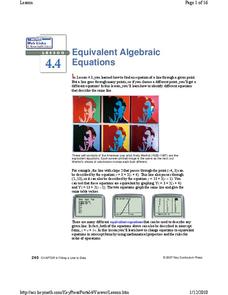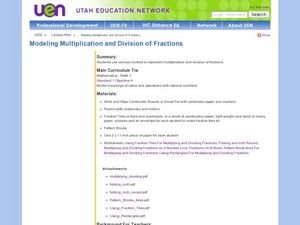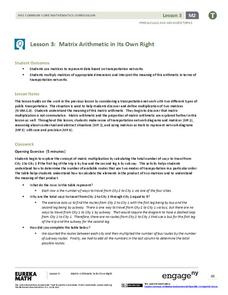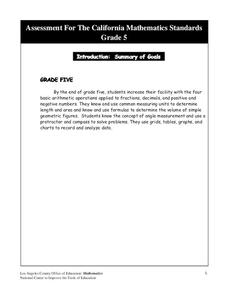BW Walch
Linear & Exponential Functions
Positioned inside the framework of linear and exponential functions, this lesson is more of an investigation into the effects of changing variables and constants inside an expression. The author takes familiar formulas, those for...
Curated OER
Four 4's
Students use the numbers 24 and 44 as well as four more fours to create a series of equations. Each equation should equal a number from 1-20. They work to find an equation for each number.
Curated OER
Solving Equations Using Two Operations
Need more detail in showing your class how to solve two-step equations and proportions? This lesson plan outlines the steps young mathematicians need to solve simple equations and check their results.
Curated OER
Is There Enough String?
Students illustrate the order of operations and evaluate expressions using the order of operations. They create and correctly at least 3 out of 4 expressions using the order of operations.
Curated OER
The Chicken Soup Problem
In this algebra worksheets students rewrite word problems using algebraic symbols. They use order of operation to solve for the variables used as they relate to multiplication and addition. There is an answer key.
Curated OER
Equivalent Algebraic Equations
Ninth graders explore linear equations. In this Algebra I lesson, 9th graders investigate how different equivalent equations can be used to describe any given line. Students explore how to change equations to equivalents...
Curated OER
Simplifying Using the Distributive Property
In this simplifying using the Distributive Property worksheet, 9th graders solve 18 various problems by applying what they know of the Distributive Property. First, they multiply each term in parenthesis by the term in front of the...
Curated OER
Algebra Preparation
In this math instructional activity, students match the pictures to the number sentence that is pieced together. They use the order of operations to simplify.
Curated OER
Missing Values
In this missing values worksheet, students solve and complete 3 various types of problems. First, they fill in the boxes on the number lines to show how to break addition and subtraction down. Then, students complete the missing values...
Curated OER
Solving Multiple-Step Problems
Students solve 2-step word problems. In this word problems lesson, students are shown examples of word problems and solutions on the board by the teacher. Then they complete a six problem worksheet independently.
Curated OER
"Zero-ing" In On Integers
Students add and subtract integers. In this integer lesson, students use models to demonstrte the addition and subtraction of integers. They describe zero pairs and write steps to add and subtract integers.
Curated OER
The Year Game: Writing Number Expressions
In this year game worksheet, students write expressions for the counting numbers one through 100 using only digits in the curent year. They do so using only the digits in the current year and using addition, multiplication,...
Curated OER
The Sum of Our Integer Intelligences
Young mathematicians explore integers. They review adding integers through engaging in mathematical labs. Each lab station is designed to reflect one of the multiple intelligences. Resources for all activities are provided.
Curated OER
Multiples of 6 #2
Count by six with these helpful activities. After completing number sequences and multiplication problems from the six times table, third graders solve problems that are written out at the bottom of the page. An excellent way to work on...
Curated OER
Finding Patterns
What's the pattern? Learners skip count to complete 12 sequences, some of which increase and some of which decrease. As they solve each number pattern they count by 2, 3, 4, 5, 6, 10, and 100, getting some extra subtraction and addition...
Curated OER
Identifying Patterns
Explore number attributes and skip counting through patterns! Scholars find the pattern in each of these sequences and continue it by writing in the remaining values. They count consistently by various intervals, sometimes forwards and...
Curated OER
Decimals Decide Olympic Champions
The class discovers how a decimal can make all the difference in the Olympics. As they learn about decimal place values, they compare and contrast data and demonstrate decimal values using manipulatives.
Curated OER
Identifying Patterns
Find the pattern! Eighteen number sequences challenge scholars to identify and complete the pattern, adding at least four digits to the given numbers. All the sequences here involve skip counting by various single-digit numbers,...
Curated OER
Identifying Patterns
Although this fractions exercise may seem difficult at first, it's really quite simple and intended for beginners to mixed numbers. Scholars complete 15 number sequences by adding two or three mixed numbers or decimal numbers. However,...
Curated OER
Modeling Multiplication and Division of Fractions
Create models to demonstrate multiplication and division of fractions. Using fraction tiles to model fractions, pupils explore fractions on a ruler and use pattern blocks to multiply and divide. They also create number lines with fractions.
EngageNY
Matrix Arithmetic in Its Own Right
Matrix multiplication can seem random to pupils. Here's a instructional activity that uses a real-life example situation to reinforce the purpose of matrix multiplication. Learners discover how to multiply matrices and relate the process...
EngageNY
Exploiting the Connection to Cartesian Coordinates
Multiplication in polar form is nice and neat—that is not the case for coordinate representation. Multiplication by a complex number results in a dilation and a rotation in the plane. The formulas to show the dilation and rotation are...
Los Angeles County Office of Education
Assessment for the California Mathematics Standards Grade 5
Test young mathematicians' knowledge with an assessment aligned to California's fifth grade state standards. The exam covers a multitude of concepts including fractions and decimals, positive and negative numbers, measurement; and...
Curated OER
Choosing a College
How can mathematics help scholars choose a college? High schoolers learn how they can use decision matrices to rank colleges based on selected criteria. They also see how to weigh criteria using multiplication of the decision matrix by a...

























